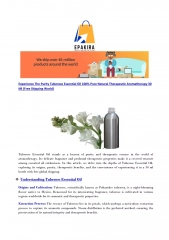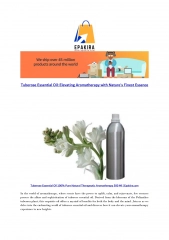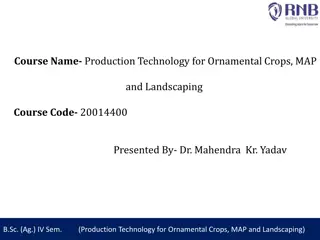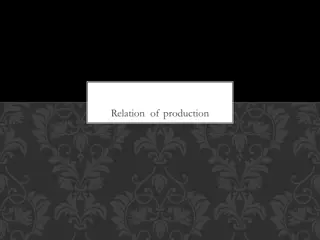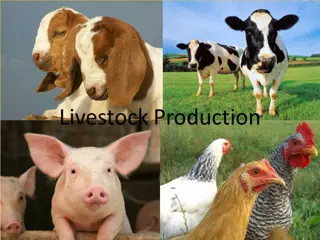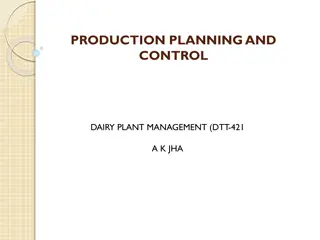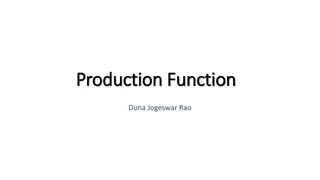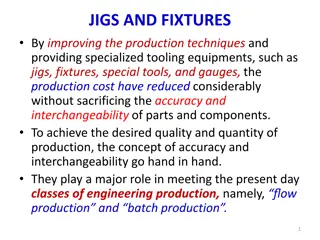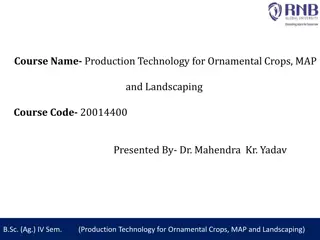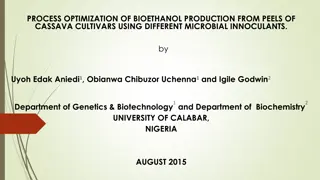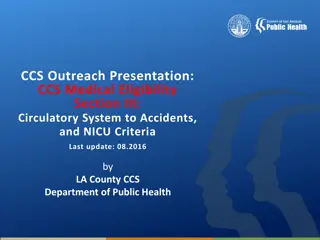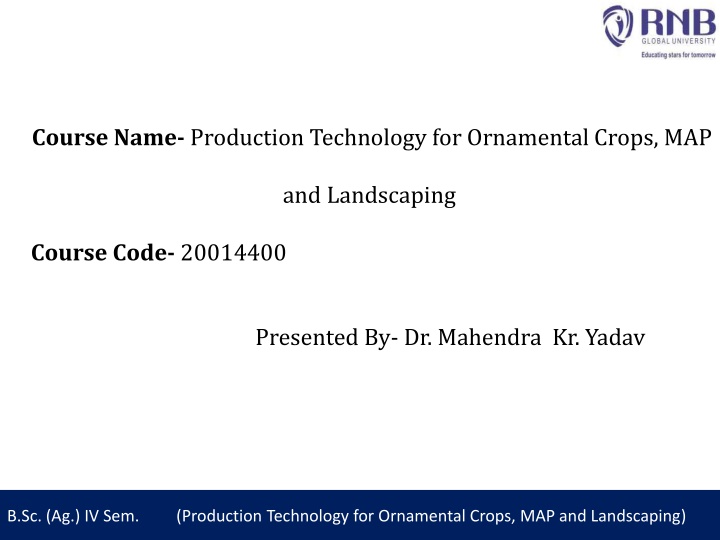
Production Technology for Ornamental Crops and Landscaping
Explore the production technology for ornamental crops, medicinal crops, and landscaping in this informative course taught by Dr. Mahendra Kr. Yadav. Learn about different types of ornamental and medicinal crops, landscaping principles, packaging practices for loose flowers, production technology of tuberose, and more. Discover the significance of processing and value addition in ornamental crops and MAPs produce. Dive into the world of ornamental horticulture with this B.Sc. (Ag.) course.
Download Presentation

Please find below an Image/Link to download the presentation.
The content on the website is provided AS IS for your information and personal use only. It may not be sold, licensed, or shared on other websites without obtaining consent from the author. If you encounter any issues during the download, it is possible that the publisher has removed the file from their server.
You are allowed to download the files provided on this website for personal or commercial use, subject to the condition that they are used lawfully. All files are the property of their respective owners.
The content on the website is provided AS IS for your information and personal use only. It may not be sold, licensed, or shared on other websites without obtaining consent from the author.
E N D
Presentation Transcript
Course Name- Production Technology for Ornamental Crops, MAP and Landscaping Course Code- 20014400 Presented By- Dr. Mahendra Kr. Yadav B.Sc. (Ag.) IV Sem. (Production Technology for Ornamental Crops, MAP and Landscaping)
Course Objectives Identify different types of ornamental and medicinal crops. Examine various principles of landscaping, uses of landscape trees, shrubs and climbers, production technology of important ornamental crops, etc. Determine about Demonstrate various Package of practices for loose flowers and their transportation, storage house and required condition for cut and loose flower. Construct about the various problems with the production technology of medicinal and aromatic plants. Importance of Processing and value addition in ornamental crops and MAPs produce. B.Sc. (Ag.) IV Sem. (Production Technology for Ornamental Crops, MAP and Landscaping)
PRODUCTION TECHNOLOGY OF TUBEROSE UNDER OPEN CONDITIONS B.Sc. (Ag.) IV Sem. (Production Technology for Ornamental Crops, MAP and Landscaping)
B.Sc. (Ag.) IV Sem. (Production Technology for Ornamental Crops, MAP and Landscaping)
B.Sc. (Ag.) IV Sem. (Production Technology for Ornamental Crops, MAP and Landscaping)
B.Sc. (Ag.) IV Sem. (Production Technology for Ornamental Crops, MAP and Landscaping)
B.Sc. (Ag.) IV Sem. (Production Technology for Ornamental Crops, MAP and Landscaping)
B.Sc. (Ag.) IV Sem. (Production Technology for Ornamental Crops, MAP and Landscaping)
B.Sc. (Ag.) IV Sem. (Production Technology for Ornamental Crops, MAP and Landscaping)
B.Sc. (Ag.) IV Sem. (Production Technology for Ornamental Crops, MAP and Landscaping)
B.Sc. (Ag.) IV Sem. (Production Technology for Ornamental Crops, MAP and Landscaping)
B.Sc. (Ag.) IV Sem. (Production Technology for Ornamental Crops, MAP and Landscaping)
B.Sc. (Ag.) IV Sem. (Production Technology for Ornamental Crops, MAP and Landscaping)
Soil Tuberose can be grown on wide variety of soils from light, sandy loam to a clay loam. The soil should be at least 45 cm deep, well drained, friable, rich in organic matter The soil should have a pH range from 6.5 to 7.5 with good aeration. Climate The crop is best suited for cultivation in tropical to subtropical and temperate climates. The crop is reported to flower profusely throughout the year, if the climate is mild and free from extremes of high and low temperature. Atemperature range from 20-30 C is considered ideal for this crop. B.Sc. (Ag.) IV Sem. (Production Technology for Ornamental Crops, MAP and Landscaping)
B.Sc. (Ag.) IV Sem. (Production Technology for Ornamental Crops, MAP and Landscaping)
B.Sc. (Ag.) IV Sem. (Production Technology for Ornamental Crops, MAP and Landscaping)
B.Sc. (Ag.) IV Sem. (Production Technology for Ornamental Crops, MAP and Landscaping)
B.Sc. (Ag.) IV Sem. (Production Technology for Ornamental Crops, MAP and Landscaping)
B.Sc. (Ag.) IV Sem. (Production Technology for Ornamental Crops, MAP and Landscaping)
B.Sc. (Ag.) IV Sem. (Production Technology for Ornamental Crops, MAP and Landscaping)
B.Sc. (Ag.) IV Sem. (Production Technology for Ornamental Crops, MAP and Landscaping)
Fertilizer application 100 kg N, 60 kg P2O5 and 40 kg K2O /ha is recommended for tuberose production. Of the full recommended dose of fertilizers, half the N, the full dose of P and K has to be applied at the time of planting and the remaining half of N is given as a top- dressing after 45 days of planting Irrigation Subsequently, the crop is irrigated at 5-7 days intervals depending upon weather conditions. In the summer months, irrigation is recommended twice a week. Effect of Growth regulators Application of both CCC at 5000 ppm and GA3 at 1000 ppm results in early flowering, increased flower stalk, number of flower florets production and improves the quality of flowers Intercultural operations In order to keep the plots free of weeds and to avoid the exposure of bulbs, the plots are weeded and earthed-up once a month. The application of Atrazine (@ 3 kg/ha) as a pre- eme8rgent weedicide keeps the plots weed- free. B.Sc. (Ag.) IV Sem. (Production Technology for Ornamental Crops, MAP and Landscaping)
B.Sc. (Ag.) IV Sem. (Production Technology for Ornamental Crops, MAP and Landscaping)
B.Sc. (Ag.) IV Sem. (Production Technology for Ornamental Crops, MAP and Landscaping)
B.Sc. (Ag.) IV Sem. (Production Technology for Ornamental Crops, MAP and Landscaping)
B.Sc. (Ag.) IV Sem. (Production Technology for Ornamental Crops, MAP and Landscaping)
Pests of tuberose Aphids Grasshoppers Red spider mites Thrips Root-knot nematode and greasy streak nematode Diseases of tuberose Stem rot Flower Bud rot Leaf blight or Botrytis blight Alternaria leaf spot B.Sc. (Ag.) IV Sem. (Production Technology for Ornamental Crops, MAP and Landscaping)

